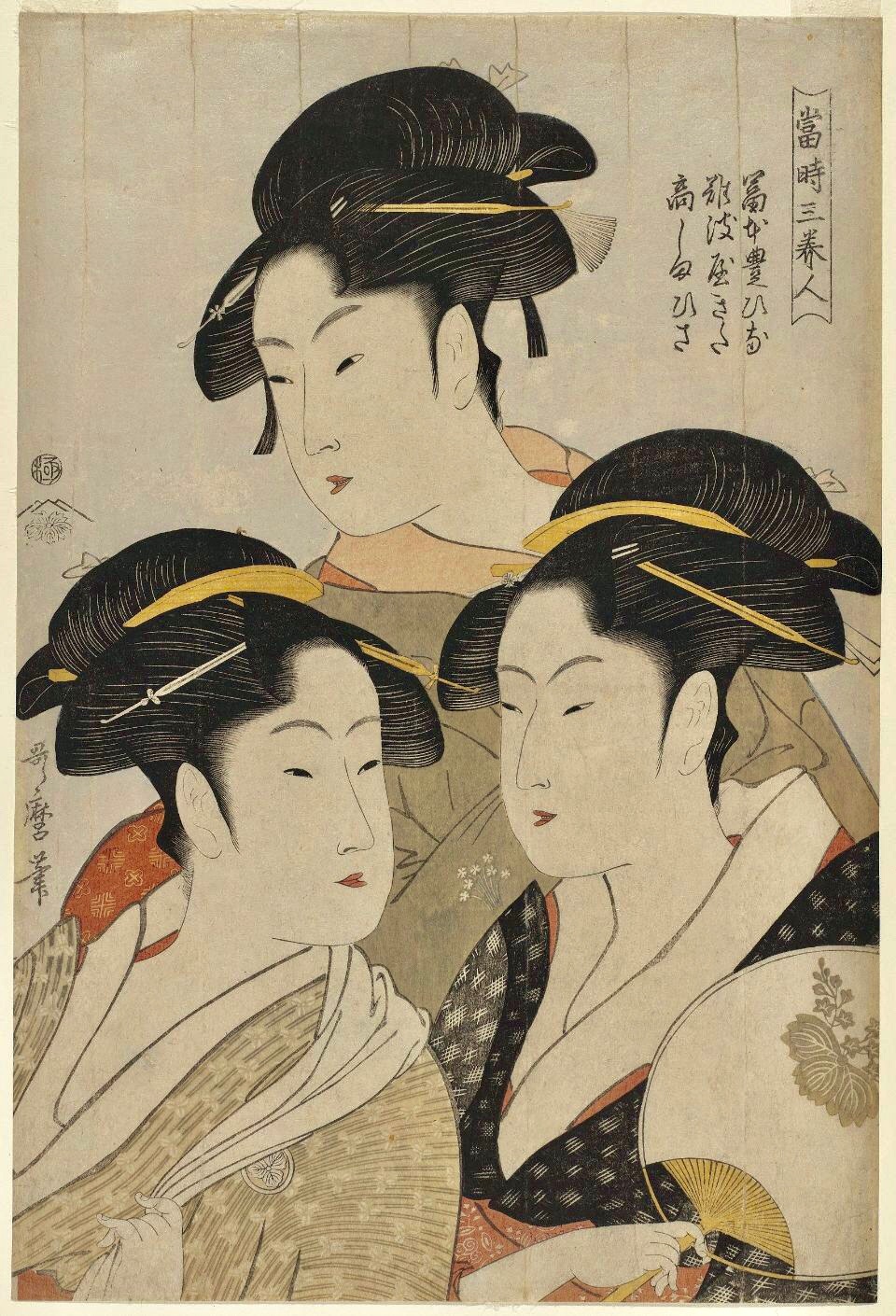The Feminine, The Fabulous, & The Floating World

LOVE GARDEN PARTY (Vite d'Acqua)’ Summer 2019 Mixed-mediums acrylics, inks, collage painting on large format digital paper stock 33”w 30”h.
In the age of the selfie, its amusing to consider the term > Bijin-ga (美人画, "beautiful person picture") which translates as pictures of beautiful women in Japanese art.
More specifically in the Ukiyo-e style of woodblock printing produced in Japan from the 17th century to the 19th century.
Besides women, popular subjects in Ukiyo-e included kabuki actors and sumo wrestlers; scenes from history and folk tales; travel scenes and landscapes; flowers and animals and erotica. The prints were very popular amongst the Japanese merchants and the middle class of the time.
Kitagawa Utamaro(c. 1753–1806) has long been my favorite of these artists. Utamaro made his name and fame in the 1790s with his unique Bijin-ga portraits, images that focused on the head and upper torso, a style others had previously been employed only in portraits of kabuki actors, the celebrities of the era. Utamaro experimented with line, color, and printing techniques to bring out subtle differences in the features, expressions, and backdrops of subjects from a wide variety of class and background.
Utamaro's work reached Europe in the mid-nineteenth century, where it was very popular, enjoying special acclaim in France with the Impressionists, particularly with his use of partial views and his emphasis on light and shade. The reference to the "Japanese influence" among these artists, most especially Vincent van Gogh and Paul Cézanne often refers to the work of Utamaro.
Three_Beauties_of_the_Present_Day c. 1793, Kitagawa Utamaro. Collection of the Museum of Fine Arts, Boston
In ‘LOVE GARDEN PARTY (Vite d'Acqua)’ a group of girlfriends gathered for cocktails on a manicured lawn is the point of interest and subject of this large format embellished digital print. My perspective suggests a view from across the table of a larger tableaux that re-contextualizes the sublime tradition and visual language of Utamaro’s Ukiyo woodcuts via the smartphone lens of Women in contemporary pop culture, the social media gaze, status and signifying, Fashion, multicultural aesthetics and urban style.









"Love Garden: Acqua Vite" – A Critical Viewing
In Love Garden: Acqua Vite, the artist presents a mesmerizing fusion of portraiture, abstraction, and collage, weaving together themes of identity, cultural expression, and nature’s organic rhythm. The painting radiates vibrancy, filled with an explosion of textures, patterns, and symbolic imagery that invites the viewer into a dreamlike, yet deeply intimate world.
The composition is rich with interwoven figures—three central subjects gaze outward with a quiet intensity, their faces painted in striking hues of gold, blue, and earthy tones. Their expressions, fragmented through photographic cutouts, suggest a layered sense of self, where the physical, emotional, and spiritual realms intertwine. The use of mixed media, blending painted surfaces with collaged elements, enhances this theme, creating a dialogue between the constructed and the organic.
Nature plays a pivotal role in the painting’s visual language. Flourishing plants, exotic flowers, and birds fill the foreground, serving as both decorative and symbolic elements. The flora and fauna interact seamlessly with the figures, reinforcing a sense of harmony between humanity and the natural world. The birds, often symbols of freedom, spirituality, and communication, seem to whisper secrets between the subjects, while the growing plants hint at themes of renewal and interconnectedness.
The inclusion of objects such as wine bottles, vessels, and table settings suggests a communal gathering—perhaps a feast or a ritualistic coming together. The text elements, featuring words like "Acqua Vite" and "Chiaro Rose," evoke a European influence, possibly referencing the Italian tradition of distilled spirits and fine wines, reinforcing themes of indulgence, pleasure, and shared experiences.
Color and texture are wielded with fearless spontaneity. Bright pinks, electric blues, and deep greens contrast against muted, earthy backgrounds, creating a composition that is both visually arresting and emotionally evocative. The juxtaposition of detailed, intricate linework with bold, expressive brushstrokes keeps the eye engaged, uncovering new details with every glance.
At its core, Love Garden: Acqua Vite is a celebration of life, culture, and identity. It invites the viewer to revel in the complexity of human connection, to embrace the beauty of diversity, and to find joy in the interplay between the natural and the surreal. The artist’s masterful use of mixed media and collage techniques transforms the painting into a tapestry of emotion, memory, and imagination—offering a glimpse into a world where beauty and meaning coexist in endless variation.

